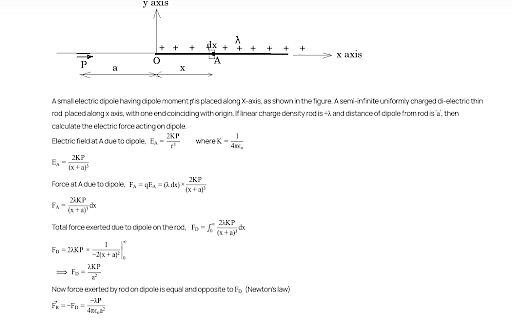A dipole of moment \(\overrightarrow{p}\) is placed in uniform electric field \(\overrightarrow{E}\) then torque acting on it is given by : -
A dipole of moment \(\overrightarrow{p}\) is placed in uniform electric field \(\overrightarrow{E}\) then torque acting on it is given by : -
\(\overrightarrow{\tau}\) = \(\overrightarrow{p}.\overrightarrow{E}\)
\(\overrightarrow{\tau}\) = \(\overrightarrow{p}\times \overrightarrow{E}\)
\(\overrightarrow{\tau}\) = \(\overrightarrow{p}+\overrightarrow{E}\)
\(\overrightarrow{\tau}\) = \(\overrightarrow{p}-\overrightarrow{E}\)
The Correct Option is B
Solution and Explanation
The correct option is (B): \(\overrightarrow{\tau}\) = \(\overrightarrow{p}\times \overrightarrow{E}\).
The dipole moment (p) of a dipole in the presence of a uniform electric field (E) can be expressed as p = qa, where 'q' represents the charge, and 'a' is the length of the dipole. When a dipole with a dipole moment 'p' is situated within a uniform electric field 'E,' it experiences a torque (τ). This torque (τ) can be calculated as either the force (F) applied to the dipole multiplied by the perpendicular distance (d) between the point of application of the force and the axis of the dipole or simply as τ = pEsinθ, where 'θ' represents the angle between the dipole moment and the electric field direction, and 'p' is the dipole moment. (or τ=p×E).
Top Questions on Electric Charges and Coulomb's Law
- Two point charges A and B, having charges. +Q and -Q respectively, are placed at certain distance apart and force acting between them is F. If 25% charge of A is transferred to B, then force between the charges becomes:
- NEET (UG) - 2019
- Physics
- Electric Charges and Coulomb's Law
- (a) Explain the meaning of the statement ‘electric charge of a body is quantised’.
(b) Why can one ignore quantisation of electric charge when dealing with macroscopic i.e., large scale charges?- Physics
- Electric Charges and Coulomb's Law
Four point charges \(q_A\)\( = 2 µC\), \(q_B\) \(= −5 µC\), \(q_C\) = 2 µC, and \(q_D\) \(= −5 µC\) are located at the corners of a square ABCD of side 10 cm. What is the force on a charge of 1 µC placed at the centre of the square?
- CBSE CLASS XII
- Physics
- Electric Charges and Coulomb's Law
- An electric dipole of moment → P is lying along uniform electric field. The work done in rotating the dipole by 90° is :
- Physics
- Electric Charges and Coulomb's Law
Two large, thin metal plates are parallel and close to each other. On their inner faces, the plates have surface charge densities of opposite signs and of magnitude \(17.0 × 10^{−22} Cm^{-2}\). What is E:
(a) in the outer region of the first plate,
(b) in the outer region of the second plate, and (c) between the plates?- CBSE CLASS XII
- Physics
- Electric Charges and Coulomb's Law
Concepts Used:
Electric Dipole
An electric dipole is a pair of equal and opposite point charges -q and q, separated by a distance of 2a. The direction from q to -q is said to be the direction in space.
p=q×2a
where,
p denotes the electric dipole moment, pointing from the negative charge to the positive charge.
Force Applied on Electric Dipole
